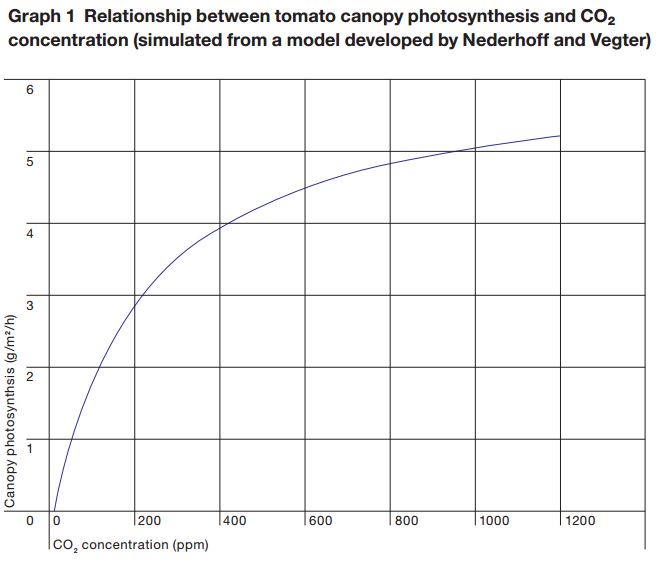Please click here to access the main AHDB website and other sectors.
- Home
- Knowledge library
- CO2 best practice guide: Background
CO2 best practice guide: Background
Carbon dioxide (CO2) is an essential component of photosynthesis, which uses light energy and CO2 to drive crop growth. The difference between the rate of photosynthesis and the rate of respiration is the basis for dry-matter accumulation (growth) in the plant.
For the majority of greenhouse crops, net photosynthesis increases as CO2 levels increase. A widely followed ‘rule of thumb’ suggests that for most crops at any given level of photosynthetically active radiation (PAR), increasing the CO2 level to 1,000 ppm will increase photosynthesis by about 50% over ambient CO2 levels.
Graph 1 (adapted from Nederhoff and Vegter, 1994), shows photosynthetic rate increases with rise in CO2 concentration up to at least 1,200 ppm. However, the response is not linear, and photosynthetic rate increases become progressively smaller as CO2 concentration rises. The relationship shown is for tomato (cv. Blizzard), but most other horticultural crops respond similarly. This information underpins the current practice of raising the glasshouse daytime CO2 concentration for many edible crops and some ornamental crops using CO2 enrichment and also underpins the fundamental commercial question of when enrichment makes economic sense, particularly at the point of diminishing returns (i.e. at higher CO2 concentrations).

At the very least, enrichment can be used to avoid CO2 depletion which occurs when its utilisation outpaces the rate of natural replacement from outside. Outside levels are commonly around 380 ppm, but, without enrichment, levels in the glasshouse can fall in summer to as low as 200 ppm, particularly when crops with a large leaf area are growing in tightly sealed glasshouses. As seen in Graph 1, this degree of depletion will reduce canopy photosynthesis by around 26%. However, depletion is not always as extreme as this, and in commercial tomato production adding only sufficient CO2 to prevent atmospheric depletion typically gives a 5–15% yield increase. It is now common, however, to enrich year-round to much higher levels than ambient, and this practice is estimated to increase yields by around 20–30%, depending on the degree of enrichment, species, crop density, etc.
The positive effects of CO2 enrichment on the rate of photosynthesis can decrease after prolonged exposure – this process is known as acclimation and has been demonstrated in tomatoes by Besford et al. (1990) and Yelle (1990)and in cucumber by Dennis (1980). The rate of photosynthesis is enhanced by an increased rate of CO2 fixation by the photosynthetic enzyme Rubisco and suppression of photorespiration. The amount of Rubisco decreases in some crops grown in elevated CO2. This leads to a loss of photosynthetic efficiency over time but still results in a long-term increased yield in comparison with a non-enriched environment. Acclimation is likely to occur more rapidly at higher CO2 concentrations. Interruption of the CO2 application for a few days would be expected to result in an improved response. The ability to avoid acclimation through, for example, variable enrichment strategies which minimise impact on yield is an area of interest and possible future research.
High CO2 concentration also decreases the stomatal conductance considerably. The net overall effect of CO2 supply on transpiration of a crop in a greenhouse, however, is a relatively small decrease the extent of the effects depends on the conditions (Nederhoff, 1994).
The level to which the CO2 concentration should be raised depends on the crop, light intensity, temperature, ventilation, stage of the crop growth and the economics of the crop. For most crops the saturation point will be reached at about 1,000–1,300 ppm under ideal circumstances. A lower level (800–1,000 ppm) is recommended for raising seedlings (tomatoes, cucumbers and peppers) as well as for lettuce production. Even lower levels (500–800 ppm) are recommended for African violets and some gerbera varieties. Increased CO2 levels will shorten the growing period (5%–10%), improve crop quality and yield, as well as, increase leaf size and leaf thickness. The increase in yield of tomato, cucumber and pepper crops is a result of increased numbers and faster flowering per plant.
Achieving target CO2 concentration depends on capacity of dosage systems and section 2 reviews current options. Nederhoff (2004) suggests a dosing capacity of 70–130 kg/ha/hr is needed to achieve 900 ppm when vents are closed and this rises to 190–580+ kg/ha/hr when vents start to open. Glasshouse design, age and crop density will all influence capacity of a dosing system to achieve desired CO2 concentrations.
Sectors:


